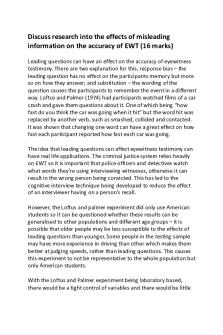Quiz Estimation of Dynamic Causal Effects PDF

| Title | Quiz Estimation of Dynamic Causal Effects |
|---|---|
| Course | Econometrics II |
| Institution | Universitat Pompeu Fabra |
| Pages | 3 |
| File Size | 96.7 KB |
| File Type | |
| Total Downloads | 94 |
| Total Views | 119 |
Summary
Stock and Watson Quiz...
Description
Chapter 15: Estimation of Dynamic Causal Effects Multiple Choice for the Web
1) Ascertaining whether or not a regressor is strictly exogenous or exogenous ultimately requires all of the following with the exception of a. b. c. d.
economic theory. institutional knowledge. expert judgment. use of HAC standard errors.
2) The impact effect is the a. b. c. d.
zero period dynamic multiplier. h period dynamic multiplier, h>0. cumulative dynamic multiplier. long-run cumulative dynamic multiplier.
3) Quasi differences in Yt are defined as a. Yt Yt1 . b. Yt 1Yt 1 . c. Yt 1Yt 1 . d. 1 (Yt Yt 1 ) .
4) GLS involves a. writing the model in differences and estimating it by OLS, using HAC standard errors. b. truncating the sample at both ends of the period, then estimating by OLS using HAC standard errors. c. checking the AIC rather than the BIC in choosing the maximum lag-length of the regressors. d. transforming the regression model so that the errors are homoskedastic and serially uncorrelated, and then estimating the transformed regression model by OLS.
1
5) HAC standard errors should be used because a. they are convenient simplifications of the heteroskedasticity-robust standard errors. b. conventional standard errors may result in misleading inference. c. they are easier to calculate than the heteroskedasticity-robust standard errors and yet still allow you to perform inference correctly. d. when there is a structural break, then conventional standard errors result in misleading inference.
6) The interpretation of the coefficients in a distributed lag regression as causal dynamic effects hinges on a. b. c. d.
the assumption that X is exogenous not having more than four lags when using quarterly data using GLS rather than OLS the use of monthly rather than annual data
7) Given the relationship between the two variables, the following is most likely to be exogenous: a. the inflation rate and the short term interest rate: short-term interest rate is exogenous b. U.S. rate of inflation and increases in oil prices: oil prices are exogenous c. Australian exports and U.S. aggregate income: U.S. aggregate income is exogenous d. change in inflation, lagged changes of inflation, and lags of unemployment: lags of unemployment are exogenous
8) When Xt is strictly exogenous, the following estimator(s) of dynamic causal effects are available: a. estimating an ADL model and calculating the dynamic multipliers from the estimated ADL coefficients b.using GLS to estimate the coefficients of the distributed lag model c. (a) but not (b) d. (a) and (b)
2
9) In time series data, it is useful to think of a randomized controlled experiment a. consisting of the same subject being given different treatments at different points in time b. consisting of different subjects being given the same treatment at the same point in time c. as being non-existent (“parallel universes” only exist in science fiction) d. consisting of the at least two subjects being given different treatments at the same point in time
10) Consider the distributed lag model Yt = β0 + β1Xt + β2Xt-1 + β3Xt-2 + … + βr+1Xt-r + ut. The dynamic causal effect is a. b. c. d.
β0 + β1 β1 + β2+…+βr+1 β0 + β1+…+βr+1 β1
3...
Similar Free PDFs

Med Surg ATI Dynamic Quiz
- 3 Pages

Esquema Causal
- 2 Pages

Causal arguments
- 2 Pages

Esquema Causal
- 2 Pages

Estimation of Ancestry 11 5
- 3 Pages

THE EFFECTS OF CORRUPTION
- 5 Pages

Environmental Effects OF Quarrying
- 18 Pages

2... Effects OF Privation
- 2 Pages

Physiological Effects of Massage
- 8 Pages
Popular Institutions
- Tinajero National High School - Annex
- Politeknik Caltex Riau
- Yokohama City University
- SGT University
- University of Al-Qadisiyah
- Divine Word College of Vigan
- Techniek College Rotterdam
- Universidade de Santiago
- Universiti Teknologi MARA Cawangan Johor Kampus Pasir Gudang
- Poltekkes Kemenkes Yogyakarta
- Baguio City National High School
- Colegio san marcos
- preparatoria uno
- Centro de Bachillerato Tecnológico Industrial y de Servicios No. 107
- Dalian Maritime University
- Quang Trung Secondary School
- Colegio Tecnológico en Informática
- Corporación Regional de Educación Superior
- Grupo CEDVA
- Dar Al Uloom University
- Centro de Estudios Preuniversitarios de la Universidad Nacional de Ingeniería
- 上智大学
- Aakash International School, Nuna Majara
- San Felipe Neri Catholic School
- Kang Chiao International School - New Taipei City
- Misamis Occidental National High School
- Institución Educativa Escuela Normal Juan Ladrilleros
- Kolehiyo ng Pantukan
- Batanes State College
- Instituto Continental
- Sekolah Menengah Kejuruan Kesehatan Kaltara (Tarakan)
- Colegio de La Inmaculada Concepcion - Cebu






